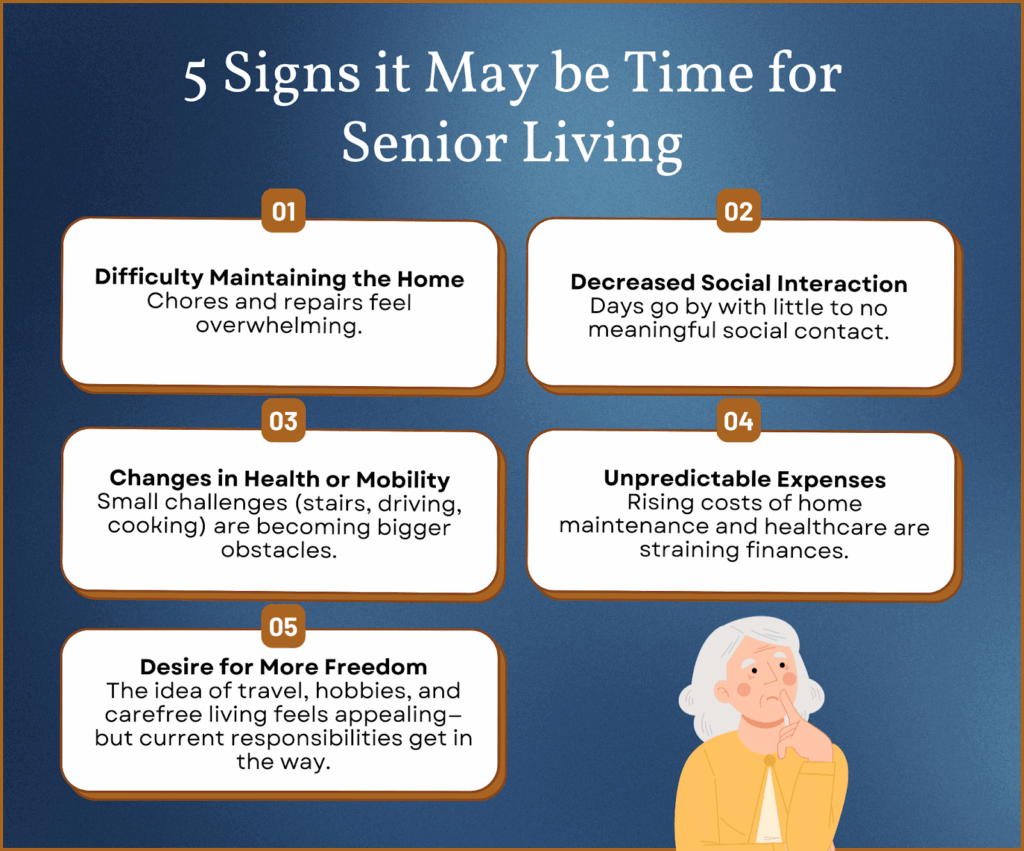
Why Wait? Knowing the Right Time to Move to Independent Living
For many older adults, the decision to move into an independent living community is put off until it feels absolutely necessary. Often, a health scare, loss of a spouse, or sudden difficulty maintaining a home triggers the move. But waiting until crisis strikes can mean missing out on years of freedom, wellness, and joy that independent living provides.
Let’s explore the realities of staying at home versus joining a vibrant retirement community, the key signs that it might be time to consider a transition, and why planning early leads to a more enriching, confident next chapter.
Why Older Adults Delay the Move
Even when the benefits of senior living are clear, it’s common for people to resist change. Here are some of the most frequent reasons:
- Emotional Attachment to Home
A house is more than just four walls—it’s decades of memories. Many seniors have lived in the same place for 30, 40, or even 50 years. The thought of leaving behind a space where children were raised, birthdays were celebrated, and traditions built can feel overwhelming.
- Perception of Independence
One of the greatest misconceptions is that moving into a retirement community means giving up freedom. Older adults sometimes equate senior living with nursing homes of the past, imagining institutional hallways instead of vibrant neighborhoods.
- “I’m Not Ready Yet” Mentality
Seniors often say they’ll move “when the time comes.” Unfortunately, this usually means waiting until after a major health issue. By then, the transition is stressful, rushed, and often decided by necessity rather than choice.
- Misconceptions About Senior Living
Outdated stereotypes still cloud perceptions. Today’s retirement communities, like Sterling Estates, are designed for independence, wellness, and connection—but many people don’t realize how much the industry has evolved. READ MORE on the myths about retirement community living.
Unfortunately, waiting too long often means missing out on the full benefits of independent living.
The Risks of Waiting Too Long
Waiting until a crisis forces the decision can create challenges for both seniors and their families.
Loneliness and Social Isolation
Research shows that social isolation can increase the risk of dementia, depression, and heart disease. When living at home, especially after losing a spouse or no longer driving, isolation can quickly set in. In contrast, independent living communities provide built-in opportunities for friendship and daily engagement.
Home Maintenance and Hidden Costs
Even if mortgage-free, owning a home is expensive. Property taxes, insurance, repairs, lawn care, utilities, and groceries add up. When you include unexpected costs like replacing a roof or fixing a leaky pipe, budgets can feel unpredictable. Senior living offers a simpler financial model: one predictable monthly fee that often covers dining, maintenance, utilities, activities, and more. READ MORE about the costs of living at home vs. senior living.
Reactive vs. Proactive Moves
Families often scramble when a parent suddenly needs support. Choices may be limited, and moves are made under stress. Moving proactively gives older adults time to select a community that feels like home, adjust at their own pace, and fully enjoy the lifestyle.
The Benefits of Independent Living
Independent living in a modern retirement community offers so much more than a safe place to live. It’s about creating a lifestyle rooted in wellness, connection, and freedom.
1. Maintenance-Free Living
No more lawn care, roof repairs, or unexpected plumbing bills. Instead, residents enjoy beautiful, well-maintained homes without the headaches.
2. Enriching Social Connections
Daily opportunities to dine with friends, attend events, and participate in clubs help residents form meaningful relationships.
3. Access to Wellness Programs
On-site fitness centers, group classes, and wellness services promote healthy aging and independence for longer.
4. Safety and Security
With 24/7 staff, emergency response systems, and secure campuses, residents and their families have peace of mind.
5. Predictable Costs
Monthly fees simplify budgeting, often covering dining, transportation, activities, and utilities—expenses that add up quickly when living at home.
6. Continuum of Care
Many retirement communities offer a range of services—from independent living to assisted living and memory care—so residents can age in place if needs change.
Signs It Might Be Time to Consider the Move
If you or a loved one are wondering whether it’s the right time to transition, here are some key signs:

Life in a Retirement Community: A Day in the Life
Imagine waking up in your private cottage or apartment, enjoying a chef-prepared breakfast, and then joining a morning yoga class or aqua aerobics session in the wellness center. Later, you might spend time gardening, attend a lecture, or take the community shuttle to a concert. Dinner is shared with friends in a lively dining room, followed by an evening movie or book club.
This rhythm reflects the balance independent living provides: freedom to choose your day, with support and opportunity at your fingertips.


